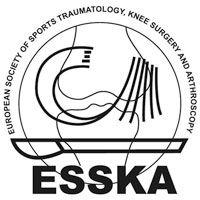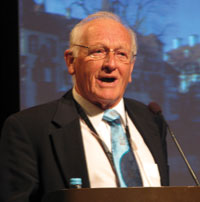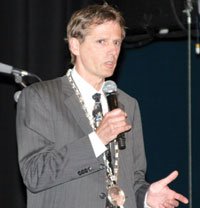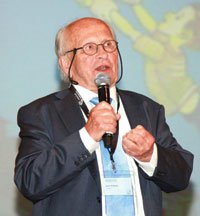ESSKA unites sports practitioners, promotes best practices and sets standards
Click Here to Manage Email Alerts
Since it was established in 1982, the European Society of Sports Traumatology, Knee Surgery and Arthroscopy has been dedicated to education, research and the exchange of scientific and clinical information, with the key goal being improved clinical practice.
“Ultimately, we want sports traumatologists to be able to provide the best clinical care to patients in order to improve the quality of their lives,” C. Niek van Dijk, MD, PhD, told Orthopaedics Today Europe. Van Dijk is professor and head of the orthopaedic department at Academic Medical Center in Amsterdam.
“Our goal is bringing together practitioners and scientists and to ensure that their knowledge is shared and the best techniques are disseminated,” said van Dijk, the current president of the organization. “Because of this, we can ensure that standards across the whole field will rise for orthopaedic sports medicine as well as for the treatment of degenerative joint disease.”
The European Society of Sports Traumatology, Knee Surgery and Arthroscopy (ESSKA) includes more than 1,400 sports traumatologists from more than 60 countries and membership continues to grow steadily every year.
“As a pan-European organization, we play a significant role in best-practice sharing and setting standards of care across borders,” van Dijk said.
The society is comprised of six scientific committees — arthroscopy, articular cartilage, basic science, sports, U45 (under 45), and education and fellowship — as well as three autonomous sections, which are the Ankle and Foot Association, European Knee Associates and the Upper Limb Section, van Dijk said.

In the ESSKA logo are the knee, meniscus and ACL depicted through an arthroscopic view, and a surgical knife. The society brings together surgeons, clinicians and scientists.
Source: ESSKA

At the 2010 ESSKA Congress, Werner Müller, MD, delivers the Ejnar Eriksson Lecture. He helped found ESSKA and was its first president from 1984 to 1988.
Image: Rapp SM, Orthopaedics Today Europe
Great potential
Ejnar Eriksson, MD, of Sweden, originally conceived the idea for a new pan-European organization.
“He saw there was an enormous scientific potential in Europe, but it was spread out because of existing national societies and all the many languages,” Werner Müller, MD, one of the ESSKA founders and first president of the group, said.
In 1982, Eriksson gathered a group of knee surgeons and arthroscopists in Berlin to discuss the foundation of what they then called the European Society for Knee Surgery and Arthroscopy (ESKA).
“The organization, initially, was kind of a club in which all friends were allowed to speak, discuss and work around knee surgery,” Giancarlo Puddu, MD, ESSKA president from 1998 to 2000 and Orthopaedics Today Europe Editorial Board member, said.
Early on, the board recognized that biennial congresses would be important for meeting the organization’s goals, according to Lars Engebretsen, MD, PhD, a professor in the department of orthopaedic surgery, Oslo University Hospital in Oslo, Norway.
“All the news and developments coming in sports traumatology are usually presented at the ESKA conference,” he said.
The first ESKA conference was held in 1984 in Berlin, with about 800 people in attendance.
“In some rooms, the interested people were standing because there were not enough seats,” Müller told Orthopaedics Today Europe. “From the exhibitors we heard the comment that the attendees eagerly followed the presentations and were only visiting the booths during the intermissions.”
Congress attendance continued to grow. “We’ve had 2,000 or more [attendees at other meetings,]” said Engebretsen, who was president from 2008 to 2010. “And this year in Geneva, I think there will be more than 2,500 [attendees].”
ESKA grew in other ways, too. Inspired by increased interest in sports trauma, the leadership added sports traumatology to the association’s scope in 1992 and renamed it the European Society of Sports Traumatology, Knee Surgery and Arthroscopy or ESSKA.
The association has influenced research. For example, working with the American Orthopaedic Society for Sports Medicine (AOSSM), ESSKA developed the International Knee Documentation Committee form, now recognized as a world standard for evaluating knee surgery results.
Fellowship is a key mission
The ESSKA-AOSSM Sports Medicine Traveling Fellowship is critical to the ESSKA mission of education.
“This fellowship enables a true meeting of minds of the best practitioners of Europe with the best of the United States,” van Dijk said. Müller and John Feagin, MD, of Vail, Colo., USA, conceived the fellowship program over dinner in 1984 and it began the following year.
The fellowship program promotes “friendship and, as a consequence, lots of cooperation on the research side,” Engebretsen said, noting his fellowship was one of the best experiences of his orthopaedic career.
Similar programs are now underway with the Asia Pacific Orthopaedic Society for Sports Medicine and the Socieadad LatinoAmericana de Artroscopia, Rodilla y Desports.
In 2012, ESSKA plans to add 40 positions to the knee replacement fellowship program and introduce the ESSKA-Chelsea (Chelsea Football Club) fellowship, which offers sports medicine-specific training, van Dijk said.

C. Niek van Dijk, MD, PhD, of Amsterdam, addresses attendees at the 14th ESSKA Congress held in Oslo in 2010, when he became ESSKA president.

Ejnar Eriksson, MD, of Sweden, originally conceived the idea for a new pan-European sports and knee trauma organization, which started as a club.
Images: ESSKA
Newsletter, journal publishing
ESSKA’s publishing program, which includes the biannual ESSKA Newsletter and a peer-reviewed journal, is an important educational tool. The newsletter, launched in 1986, includes articles on activities of the various committees and fellowship programs, surgical techniques and congress news, Puddu noted.
In 1993 ESSKA introduced the Knee Surgery, Sports Traumatology and Arthroscopy (KSSTA) journal. Although it initially struggled to attract papers, by 1995 the quality of its published material was high enough that the U.S. National Library of Medicine included it in Index Medicus and MEDLINE.
The organization remains focused on the future, according to van Dijk. The publishing program is expanding, courtesy of a recently launched book line and a new online journal that provides basic science information in orthopaedic sports medicine. ESSKA is also helping develop a subspecialty certificate in sports traumatology and sports medicine, according to Engebretsen, and work is underway to develop the curriculum and achieve accreditation.
“Like with every organization, there is always more to do than you necessarily have the resources for, so we need to stay focused on what is most relevant and prioritize these,” van Dijk said. It is important that “[we] try new things and always follow our mission to bring together orthopaedic surgeons, clinicians and scientists in Europe, with the ultimate aim to improve musculoskeletal function and quality of life of our patients.” – by Colleen Owens
References:For more information:
- www.esska.org
- Eriksson E. The history of KSSTA. Knee Surg Sports Traumatol Arthrosc. 2012;20:1. doi:10.1007/s00167-011-1764-x.
- European Society of Sports Traumatology, Knee Surgery and Arthroscopy. The ESSKA history. Available at www.esska.org/en/about/history. Accessed: March 6, 2012.
- Lars Engebretsen, MD, PhD, can be reached at +47-48400648; email: lars.engebretsen@medisin.uio.no.
- Werner Müller, MD, can be reached at Spechtweg 10, CH-4125 Riehen, Switzerland; +41 61 6010265; email: w.u.mueller@datacomm.ch.
- Giancarlo Puddu, MD, can be reached at Clinica Valle Giulia, Via G. De Notaris 2B, 00197 Rome, Italy; +39 068552982; email: giapu@tin.it.
- C. Niek van Dijk, MD, PhD, can be reached at Meibergdreef, 91105 AZ Amsterdam, Netherlands; +31 205 662938; email: c.n.vandijk@amc.uva.nl.
- Disclosures: Van Dijk is a consultant to Smith & Nephew. Engebretsen, Müller and Puddu have no relevant financial disclosures.
